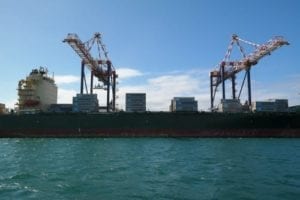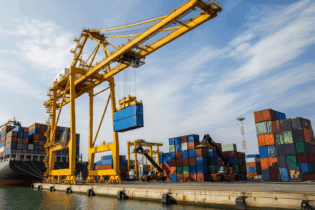New, out of the box thinking is needed by South African ports to accommodate larger vessels. This is according to Ton Bestenbreur, independent ports operations and logistics consultant at the university of Stellenbosch. Bestenbreur was speaking at the annual African Ports Evolution conference and exhibition in Durban this week.
“Maersk Line desires 6 000 container moves in under 24 hours for its 18 000 TEU vessels. This translates into 250 container moves per Gross Ship Working Hour or between 40 and 50 average quay crane moves per Gross Crane Hour. This is more than double the figures we currently achieve,” he said. “The emphasis now is no longer on individual quay crane productivity and no longer on vessel working productivity, but on berth productivity.” Bestenbreur said that more and more 18 000 TEU+ vessels are sailing from East to West and that more and more 12 000 TEU vessels are being diverted from the North to the South on that route. He suggested that South African ports stand to receive 12 000 TEU vessels in the near future which, in length terms, are not much smaller than 18 000 TEU vessels. “South Africa needs to be prepared for these vessels by thinking out of the box. We need to forget about the things we have done before and are currently doing. When we want to enter this new league, we’ve got to start thinking in a different way.” He suggested we move containers perpendicular from the crane to stack and have the quayside transfer unit system operate in perpendicular mode. Each crane would have its own delivery and collection systems, which wouldn’t interfere with neighbouring cranes.According to Bestenbreur, the three main service level constraints in container terminal operations are quayside handling, the quayside transfer unit system and the stacking yard/stack handling system.
Quay cranes would need to operate in a cluster configuration, which they are currently unable to do, because of parallel traffic underneath. He added that shuttle carriers outperform any other transfer unit system currently in operation. He further explained that reduction in cycle times could be achieved from higher equipment speed and by substantially improved operational and logistical flexibility. “Shuttle carriers don’t have the rigidity of an automated guided vehicle system and can create quay crane and stack buffers,” he pointed out. Bestenbreur said that many terminal operating systems today suffer from the inability to create buffers, either under the crane or in front of the stack. “There is no terminal operating system that is just-in-time; there are always delays, there is always the need for a crane to drop the container on the ground or for a shuttle carrier to drop the container right in front of the stacking crane. A system that enables the operator to create buffers is, therefore, much preferred,” he said. “What is needed is active container dwell time control where you keep the stack as low as possible. It is good to split the stack in a low dwell time stack and in a stack that consolidates the containers.” Bestenbreur said an alternative would be the use of wet and dry ports, where the wet port is used to stack the containers for not more than two or three days, after which they’re moved to the inland port.







